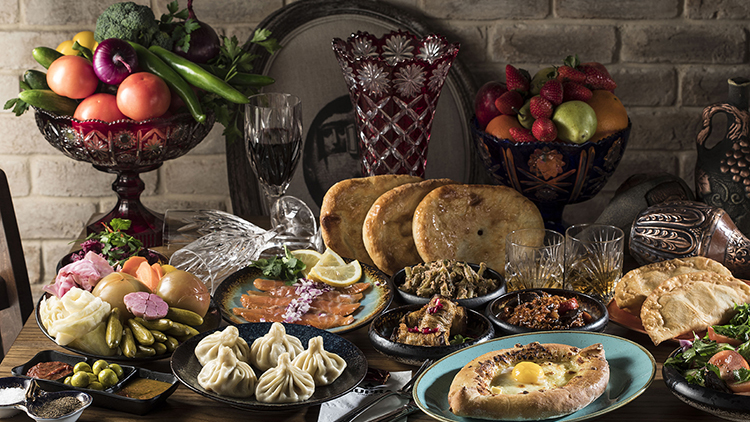Introduction
Georgian cuisine is a culinary treasure trove that reflects the country’s rich history, diverse geography, and vibrant cultural traditions. Situated at the crossroads of Europe and Asia, Georgia has been influenced by various civilizations, resulting in a unique and flavorful cuisine. From the delectable cheese-filled bread to the mouthwatering meat dishes, Georgian cuisine offers a delightful journey for food enthusiasts. In this blog, we explore the essence of Georgian cuisine, its signature dishes, and the cultural significance that makes it an integral part of the nation’s identity.
A Feast of Bread and Cheese
1. Khachapuri: Khachapuri, often described as Georgian cheese-filled bread, is an iconic dish that comes in various regional variations. The Adjarian khachapuri, shaped like a boat and filled with cheese, butter, and a cracked egg, is especially popular.
2. Megruli Khachapuri: Megruli khachapuri is another beloved variation, featuring a stuffed cheese filling, often topped with melted cheese for an indulgent delight.
3. Imeruli Khachapuri: Imeruli khachapuri is a simpler version with a cheese-filled flatbread, offering a pure and satisfying taste of the country’s culinary traditions.
Savoring Meat Delicacies
1. Khinkali: Khinkali, Georgian dumplings, are a culinary delight stuffed with spiced meat (usually beef or pork) and served with a flavorful broth. Part of the enjoyment is in the way they are eaten – lifted by the topknot, the broth is first sipped before devouring the meaty goodness.
2. Mtsvadi: Mtsvadi, also known as Georgian barbecue, consists of skewered and grilled meat, typically made from pork or lamb, marinated in aromatic spices and herbs.
3. Chakapuli: Chakapuli is a traditional Georgian stew made with lamb or veal, flavored with tarragon, coriander, and white wine, and served during festive occasions, especially in spring.
Delectable Vegetarian Dishes
1. Badrijani Nigvzit: Badrijani nigvzit is an appetizer consisting of fried eggplant slices filled with a walnut paste, creating a delightful blend of textures and flavors.
2. Lobio: Lobio is a traditional Georgian bean dish, often seasoned with spices, herbs, and garlic, and served with freshly baked bread.
3. Pkhali: Pkhali is a popular vegetarian dish made from chopped vegetables, usually spinach, beets, or cabbage, mixed with ground walnuts and herbs.
Wine: The Soul of Georgian Cuisine
1. Ancient Winemaking: Georgia is one of the oldest wine-producing regions in the world, with a history dating back over 8,000 years. The traditional winemaking method, called “qvevri” winemaking, involves fermenting wine in clay vessels buried underground.
2. Wine Varieties: Georgia boasts a rich variety of grape species, each producing distinct wines. Notable varieties include Saperavi (red), Rkatsiteli (white), and Kakhuri Mtsvane (white).
3. Toasting Traditions: Georgians have a strong culture of toasting, or “supra,” during gatherings and feasts. Toasts are an integral part of Georgian hospitality, celebrating life, friendship, and the joys of the moment.
Conclusion
Georgian cuisine is a celebration of flavors, traditions, and the strong bond between food and culture. From the iconic khachapuri to the flavorful khinkali and mouthwatering meat dishes, every bite tells a story of Georgia’s history and culinary heritage. The country’s love for wine, expressed through ancient winemaking methods and heartfelt toasts, adds a soulful dimension to the gastronomic experience. Georgian cuisine is more than just food; it is a reflection of the warmth of Georgian hospitality, the harmony of diverse cultural influences, and the pride of a nation in its culinary legacy. Embracing Georgian cuisine is an invitation to savor the essence of this enchanting country and its passionate people, making it an unforgettable journey of flavors and traditions.





0 Comment